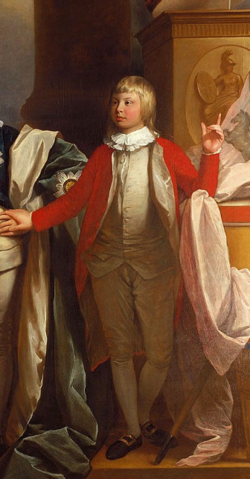Tommen I
| Tommen I | |||||
|---|---|---|---|---|---|
| King of the Anglish Empire, Protector of the Realm, First of his name. | |||||
 Tommen painted by Vetullian painter De Pici in 1694. | |||||
| Reign | 6 October 1695 – 11 April 1697 | ||||
| Coronation | November 1695 | ||||
| Predecessor | Eric I | ||||
| Successor | Robert V | ||||
| Born | Tommen Vieri 17 August 1683 Retoria | ||||
| Died | 11 April 1697 (aged 13) Belfast Tower, Retoria, Angland | ||||
| Burial | |||||
| Lady Brianna of Priza | |||||
| |||||
| House | House of Vieri | ||||
| Father | Robert IV | ||||
| Mother | Allison Ecclestark | ||||
King Tommen I (b; 17 August 1683 d; 11 April 1697) was King of the Angles and Protector of the Realm. A member of the House of Vieri, he was the eleventh and final ruler of the dynasty and the younger brother of Eric I, often known as Eric the Harsh, and son of king Robert IV. His reign began during a difficult time following the poisoning of his elder brother who had left Angland in a poor state due to his lavish spending and harsh ruling, leaving Tommen to rule a nation aged only 12 in 1695.
Early Life
Prince Tommen Vieri was born in the summer of 1683 as the second born son of Robert IV and Allison Ecclestark. He was born in an unknown location within the city of Retoria, likely in an estate house or a private hospital. Little attention was placed on Tommen by the public in his earlier years, with his elder brother Eric held up as heir to the throne and Tommen cast aside with no hope of becoming king. Early maestors that spent time around the boys commented on Tommen's temperament described as being much more polite and quiet than his older brother who seemed to be power hungry and spoiled with ideas of ruling.
When his father died in 1890 his elder brother Eric became king of Angland. His reign began with around 20 executions of nobles within his first year, many began to become worried as the king appeared spoiled and borderline psychopathic. Eric used his power often to torment Tommen, once having his childhood pony killed in front of him. As the years went on, Eric had continued to gain reputation as bloody and harsh with Frederick Ecclestark, their grandfather, having to get involved with Eric and taking away part of his power.
Arranged Marriage
Upon the death of his brother his former wife, Lady Brianna of Priza, was left widowed. Brianna was bestowed to his brother upon birth as part of an arranged marriage to tie the monarchy of Vetullia with that of the Anglish crown, Brianna being the daughter of Charles VIII. Following the death of Eric, Charles wanted the money payed to Angland back as his daughter did not provide an heir to the former king. However Frederick Ecclestark, Tommen's grandfather, came to an agreement that Brianna would be given to Tommen as wife to make amends to Vetullia.
Tommen and Brianna were married at Eastminster Chapel in later 1695.
Reign
His elder brother Eric died following a poisoning at his own wedding in 1695, leaving the throne empty to heir apparent Tommen. Despite not wanting to Tomen was placed onto a throne of glass, with both of his predecessors damaging the reputation of House Vieri. Tommen's age did not assist in this reputation as he was crowned aged 12 so those in the nation expected the worst from the young kind. Despite this, due to an ancient cultural tradition, he could not directly use all of his powers to rule until he was aged 15, so he would be given the choice to elect a council. The first member on his council was his grandfather Frederick Ecclestark who was renowned for his tactitional prowess. Another notable member of the council was Amalric Melisande, a Yerezhan man who was the first foreigner to serve on an Anglish Royal Council as well as Thomas Wells who served as almoner and cardinal of the catholic church, keeping relations with the Pope positive.
Death
Tommen's death is shrouded in debate by historians, with two primary sources claiming two different ways for the young kings death.
The first interpretation, and the one most historians now agree to be accurate to his death, was claims of suicide by his handmaiden who watched him jump from the highest window in Belfast Tower upon knowing his fate while the city was breached by northsmen. This is backed up by accounts by civilians who claim to have seen him fall from the building and the diary of his handmaiden who writes about how she could only watch as the king removed his crown and jumped.
The second interpretation is the one written by the northsmen that Robert Graff entered the top floor of the tower, where Tommen was accompanied by women, and he executed him on the spot. This is debated and often not accepted by historians as it is seen as an attempt to make Tommen look weak by the victors, who did not like the idea the young king had killed himself.
Burial and Legacy
Tommen's body was not recovered following the battle, leading to the belief his death was by suicide. His body likely fell to the streets, where fighting occurred, and was lost in the crowds. In 2016 a charity named "Tommen's Trust" dedicated to finding his body, searching through records of mass burial to find a description similar to his and digging to find it. In 2018 his body was recovered underneath the Retoria Children's Hospital, which had been built over the kings burial place. His body, upon being recovered, was placed in Eastminster Chapel, alongside most of his ancestors and predecessors.
References
